Congratulations! You have happened upon our website, where you’ll find information on all our future and past events (going back to 2010!). We are Nerd Nite SF, a monthly lecture-in-a-bar series where people from all walks of life give presentations on everything from video game design to historic shipwrecks. We’ve hosted mimes, musicians and everyone in between, with the goal of being entertaining, silly, and most of all, educational. Come learn a new fact, make a new friend, or try a new drink! Rickshaw Stop creates a special drink based on the month’s presentations!
Welcome to Nerd Nite SF, 3rd Wednesdays at Rickshaw Stop!
Nerd Nite SF #117: Baroque, Bones, and Badasses!
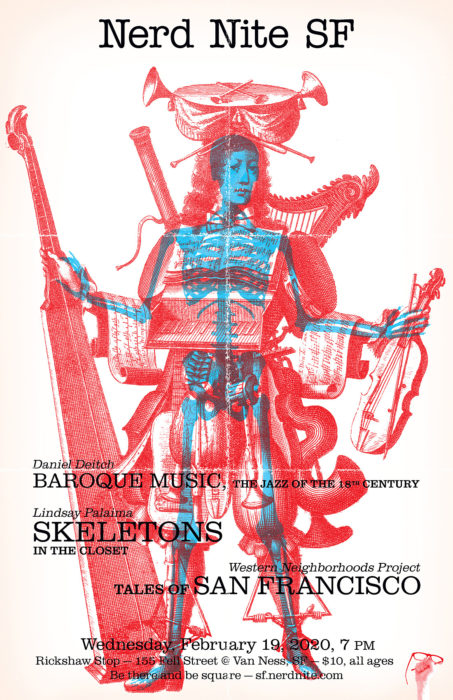 Wednesday, 2/19/2020
Wednesday, 2/19/2020
Doors at 7pm, show at 8
Rickshaw Stop, 155 Fell St @Van Ness
$10, all ages
(For $50, you also get a Western Neighborhoods Project membership, with exclusive and discount access to WNP’s excellent programs, the Outside Lands magazine, and support for a wonderful institution!)
Tickets here
At this month’s show, we go for baroque, bone up on a bone collector, and blow the lid off an incredible open source archive during a very special evening curated by our friends, stalwart stockpilers and disseminators of San Francisco history–the Western Neighborhoods Project! As always, we’ll bring the drinks, eats, music, and learning, and you bring the curious. Be there and be square!
————————
“Baroque Music, the Jazz of the 18th Century” by Daniel Deitch
Songs are written precisely on sheet music, and that’s exactly how they are meant to be played. Right? No! In the Baroque era, music was alive with improvisation–extemporaneous counterpoints over a cantus firmus, embellished melodies over ostinato chord patterns, and basso continuo, among other delights. But the industrial revolution destroyed this ancient art. Improvisation would have to wait until the 20th century to be reborn as jazz in western music.
Daniel is a professional musician and woodwind instrument repair person. He plays woodwind instruments in their modern and early forms as well as viola da gamba and cello. He’s run a woodwind repair shop on Clement Street for 25 years and performs in at least five historically informed orchestras and chamber groups.
————————
“Skeletons in the Closet” by Lindsay Palaima
Should you ever receive an invite to visit “The Bone Palace,” some trepidation would be understandable! But in this case, you are being invited to admire an incredible collection of osteological specimens assembled over a lifetime and stored in a basement. Hear about late San Franciscan Ray “Bones” Bandar and the legacy of his collection of more than 7,000 skulls.
Lindsay is a marine mammal enthusiast and museum wonk, and works as a collections registrar at the California Academy of Sciences, a nonprofit natural history museum and aquarium in Golden Gate Park.
————————
“Tales of San Francisco” by Western Neighborhoods Project
Badass teenagers, a future crusader, movable buildings, and marginal details–these are just some of WNP’s favorite stories that have emerged from the OpenSFHistory project, which has digitized and published nearly 50,000 photos of SF from the 1850s through the 1990s and pinned them to an interactive map that you can search and explore. (Go on! Look up your neighborhood. We’ll wait!) Discover some amazing San Franciscans and learn what goes into researching and building this open source historical archive.
David Gallagher is co-founder of the Western Neighborhoods Project, a 501(c)(3) California nonprofit that preserves, interprets, and shares the history of SF’s west side. Nicole Meldahl is the executive director of WNP as well as an archivist, public historian, and award-winning journalist who has lived and worked in SF since 2002. Together they launched OpenSFHistory, which, according to server data, a lot of people have spent a lot of time on when they’re supposed to be working.
————————
With: Alpha Bravo, who’ll be spinning tunes specially selected to match our presenters’ themes. Follow the set list on Twitter @djalphabravo Tremendous thanks to the Western Neighborhoods Project for guest-curating this program!
Food: And delicious bao from Cross Hatch Eatery.
NNSF #116: Bacterial Friends, Exploding Stars, and WW2 Botany!
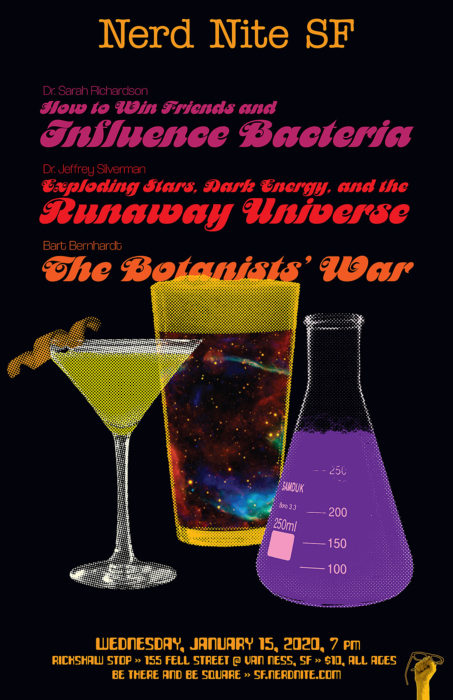
Press the space bar on your Dry January and come join us for boozy lectures, DJ Alpha Bravo, a full bar, and delicious eats. Be there and be square!
Wednesday, 1/15/2020
Doors at 7pm, show at 8
Rickshaw Stop, 155 Fell St @Van Ness
$10, all ages
Tickets here
———————————
“How to Win Friends and Influence Bacteria” with Sarah Richardson
Bacteria run this planet. We humans are brash, crass, and tacky pretenders to the throne. If we don’t start learning and collaborating with bacteria instead of ignoring or controlling them, they’re definitely going to snigger at us as we crash on past them into extinction. We’ve made some mistakes (NEVER go full petroleum!), but what up-and-coming species hasn’t? There’s still time to correct: we just need to borrow a trick from cows. We should form a direct democracy of microbes and people. After all, we’re all biomass.
A “germ wrangler”, aka a computational and molecular biologist, Dr. Richardson specializes in genomes and is the CEO of MicroByre, taming bacteria for biomanufacturing.
———————————
“Exploding Stars, Dark Energy, and the Runaway Universe” by Dr. Jeffrey Silverman
Some of the most energetic and fascinating objects in the Universe are exploding stars known as supernova. These colossal outbursts result from the deaths of stars and for a time can outshine the entire galaxy in which they’re found. Elements necessary for life are built up in stars during their lifetimes and are spread throughout space during these supernova explosions. Observations of distant supernova provided the first evidence that the expansion of the Universe is speeding up with time, rather than slowing down. This wholly unexpected phenomenon is likely due to a repulsive “dark energy” and has become one of the biggest unsolved mysteries in modern science.
Jeffrey Silverman is Director, Data Science & Analytics at Samba TV where he uses Big Data to, among other things, figure out exactly how many people watched Game of Thrones. Before tech, he earned his PhD at UC Berkeley working on supernovae and dark energy with Prof. Alex Filippenko.
(Jeffrey is also the co-host of Big Screen Science, a monthly movie showing followed by a science presentation at the Alamo Drafthouse Cinema in SF, that we highly recommend!)
———————————
“The Botanists’ War” by Bart Bernhardt
Commando raids, political intrigue, heroic sacrifices, tragic deaths, and… plant science? This is the tale of two scientists–one Nazi, one Soviet–who sought to transform agriculture and save millions of people from suffering, and whose research and lives became strangely intertwined during World War II.
Bart is a co-organizer of Nerd Nite SF and is fascinated by great assholes in science history, of which there are some in this story.
———————————
With: Alpha Bravo, who’ll be spinning tunes specially selected to match the presenters’ themes. Follow the set list on Twitter @djalphabravo.
Food: Grilled Cheese Guy, the master of the grilled cheese sandwich, returns!
Nerd Nite SF #115: Immersive Media, Shark Electrosensors, & Insect Farms!
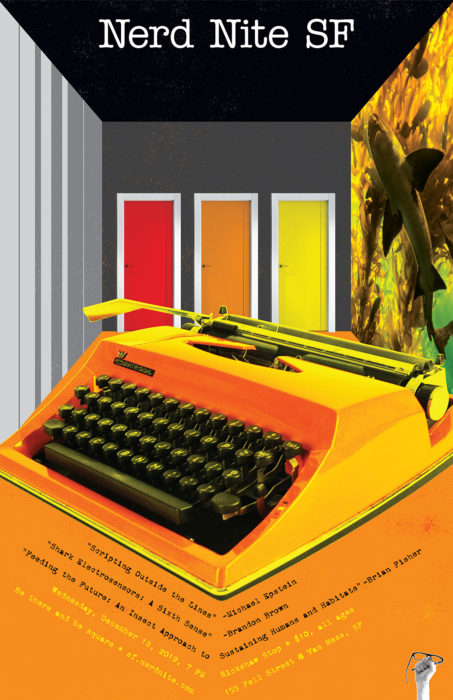 It’s December once more, which means it’s a great time to learn a whole bunch of strange, interesting, and funny things so you have a quiverful of “well actually’s” to spring on bewildered family members over holiday dinners. Come join us for boozy lectures, DJ Alpha Bravo, a full bar, and delicious eats. Be there and be square!
It’s December once more, which means it’s a great time to learn a whole bunch of strange, interesting, and funny things so you have a quiverful of “well actually’s” to spring on bewildered family members over holiday dinners. Come join us for boozy lectures, DJ Alpha Bravo, a full bar, and delicious eats. Be there and be square!
Doors at 7pm, show at 8
Rickshaw Stop, 155 Fell St @Van Ness
$10, all ages
Tickets here
———————————
“Scripting Outside the Lines” with Michael Epstein
How do you write a script for a story where the audience’s reactions — and their surroundings — will end up driving the plot and character development? That’s an incredible challenge in the age of AR/VR/XR, interactive Netflix shows, escape rooms, and participant theater. These are all “immersive media” where you are, if not the star, at least a castmember. And it requires a totally different way of storytelling.
Michael Epstein is an immersive media producer at Walking Cinema and Professor of interactive storytelling at California College of the Arts. We’ll look at various ways immersive scripts are being written and talk about Michael’s own writing process that incorporates urban landscapes, hidden artifacts, serendipity and community participation.
———————————
“Shark Electrosensors – A Sixth Sense” with Brandon Brown
As we stub our toes in the dark, or spin around helplessly trying to figure out which way is “North” when our phones can’t connect to a network, it sometimes feels like we could do with an extra sense or two. And some animals have them – in the murky depths, sharks and their relatives are able to detect electricity and use it to navigate their world. We’ll explore the physics, chemistry, and biology behind these “electrosensors” and “see” what a shark’s “electric vision” might be like.
Brandon is a Professor of Physics at the University of San Francisco whose lab focuses on electric and magnetic sensory abilities of animals. He’s also an author, and his most recent book is “The Apollo Chronicles: Engineering America’s First Moon Missions“.
———————————
“Feeding the Future: An Insect Approach to Sustaining Humans and Habitats” with Brian Fisher
Journey from San Francisco to Madagascar with Brian Fisher, PhD, an entomologist at the California Academy of Sciences. As the climate crisis unfolds and biodiversity vanishes in what is now considered the sixth mass extinction, Fisher is on the front lines tracking big-scale changes—all with the help of insects. By closely monitoring invertebrate populations, which rapidly respond to changes in their environment, Fisher is developing a system to flag early signs of ecosystem collapse. There’s no better place to put this monitoring tool to the test than off the coast of East Africa on the island nation of Madagascar. Here, the Malagasy people face a malnutrition crisis: Tropical forests are disappearing at unprecedented rates to make way for pastures and cropland. Fisher searched for a win-win alternative until he found a solution that chirped. In 2017, he and his collaborators launched Valala Farms, a Malagasy organization that produces protein-packed cricket powder to fight food insecurity and alleviate pressure on endangered species habitat. Today, Valala Farms delivers both meal supplements and insect-farming methods—which are easily replicated—to villages in need across the country. Join us for a fascinating discussion about the global biodiversity crisis, the need for breakfast before conservation, and how often-forgotten insects are fueling the future.
———————————
With: Alpha Bravo, who’ll be spinning tunes specially selected to match the presenters’ themes. Follow the set list on Twitter @djalphabravo.
Food: The very delicious Venezuelan fare of Miss Arepita.
Nerd Nite SF #114: Autopsies, Jane Austen, and Aliens!
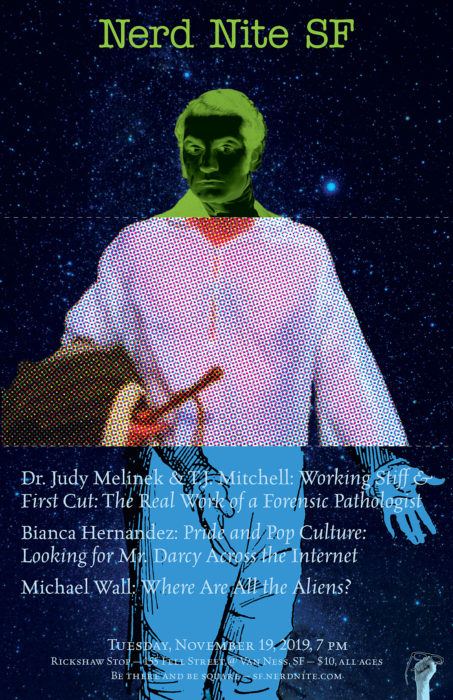 What’s this? A TUESDAY?! November scheduling shuffles have temporarily moved us to a new night, but we’ll still have the same fantastic show.
What’s this? A TUESDAY?! November scheduling shuffles have temporarily moved us to a new night, but we’ll still have the same fantastic show.
Brace yourselves, for there will be much swooning and we are rather short on fainting couches! There will be talks on autopsies, shirtless Mr. Darcys, and little green men. To steel your nerves, there will music by DJ Alpha Bravo, a full bar, and delicious eats. Be there and be square!
Tuesday, 11/19/2019
Doors at 7pm, show at 8
Rickshaw Stop, 155 Fell St @Van Ness
$10, all ages
Tickets here
———————————
“Working Stiff & First Cut: The Real Work of a Forensic Pathologist” by Dr. Judy Melinek and T.J. Mitchell
Dr. Judy Melinek performs autopsies for a living. Her husband, T.J. Mitchell, is a writer. Together they will answer everything you dare ask a medical examiner, give you a tour of the morgue, take you through a scene investigation and autopsy, and explore the science of gunshot wounds in a real-life, true-death case study. Drink up and gird yourselves for graphic photos!
Judy and T.J. are the authors of Working Stiff, about forensic pathology in the real world, not that CSI nonsense. Their new novel, First Cut, is available for pre-order at drworkingstiff.com. They will also have signed and dedicated paperbacks for sale and will answer your questions about forensics, writing narrative nonfiction, dumb ways to die, and anything else!
———————————
“Pride and Pop Culture: Looking for Mr. Darcy Across the Internet” by Bianca Hernandez
This illustrated presentation dives into the world of Jane Austen’s lasting legacy in the internet age by discussing how the idea of Mr. Darcy, her iconic hero, has been changed through pop culture. Starting with the novel itself, we will chart a course through movies, television and fanfiction to highlight the unique legacy that has developed around Mr. Darcy and what it has to do with technology. Bring your smelling salts because there WILL be photos.
Bianca Hernandez is a board member for the Jane Austen Society of North America, meme-witch for Drunk Austen (the biggest Jane Austen fan community on the internet), and enjoys long walks on the beach to find the perfect spot for lightsaber fights.
———————————
“Where Are All the Aliens?” by Michael Wall
As Carl Sagan once said, there are billions and billions of stars in the universe; a number so vast that if even just the tiniest fraction have planets that could support life, we should have company. So why haven’t we found them, or vice versa? And if we do, what then? Since “Storm Area 51” was a bust, we’ll have to to turn to science to answer these questions.
Michael is the author of “Out There: A Scientific Guide to Alien Life, Antimatter, and Human Space Travel (For the Cosmically Curious).” A reformed herpetologist, he’s a senior science writer for Space.com.
———————————
With: Alpha Bravo, who’ll be spinning tunes specially selected to match the presenters’ themes. Follow the set list on Twitter @djalphabravo.
Food: As always, we’ll have a yummy pop-up food vendor.
Nerd Nite SF #113: Sharks, Seaweed, and SF Streets!
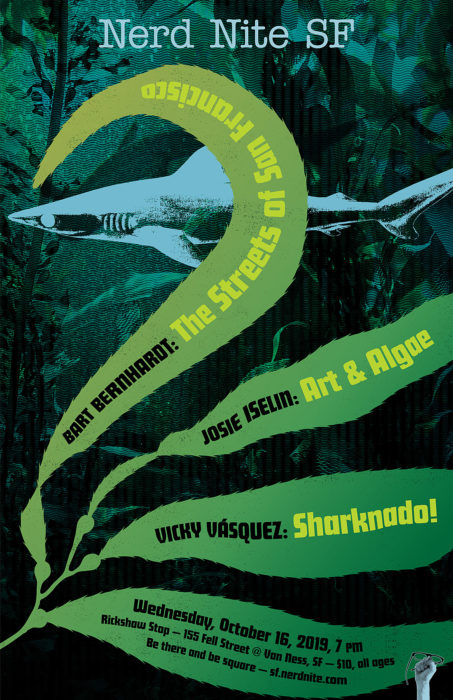 Take a deep breath and pinch your nose as we dive from the SS Rickshaw Stop and into a world of sinuous seaweed and shimmering sharks! We’ll transform algae into art and discover new species, and if that’s not enough to lure you out, we have DJ Alpha Bravo, a full bar, and Grilled Cheese Guy as bait. See you there, chums!
Take a deep breath and pinch your nose as we dive from the SS Rickshaw Stop and into a world of sinuous seaweed and shimmering sharks! We’ll transform algae into art and discover new species, and if that’s not enough to lure you out, we have DJ Alpha Bravo, a full bar, and Grilled Cheese Guy as bait. See you there, chums!
Wednesday, 10/16/2019
Doors at 7pm, show at 8
Rickshaw Stop, 155 Fell St @Van Ness
$10, all ages
Tickets here
With: Alpha Bravo, who’ll be spinning tunes specially selected to match the presenters’ themes. Follow the set list on Twitter @djalphabravo.
Food: The master of the grilled cheese sandwich returns!